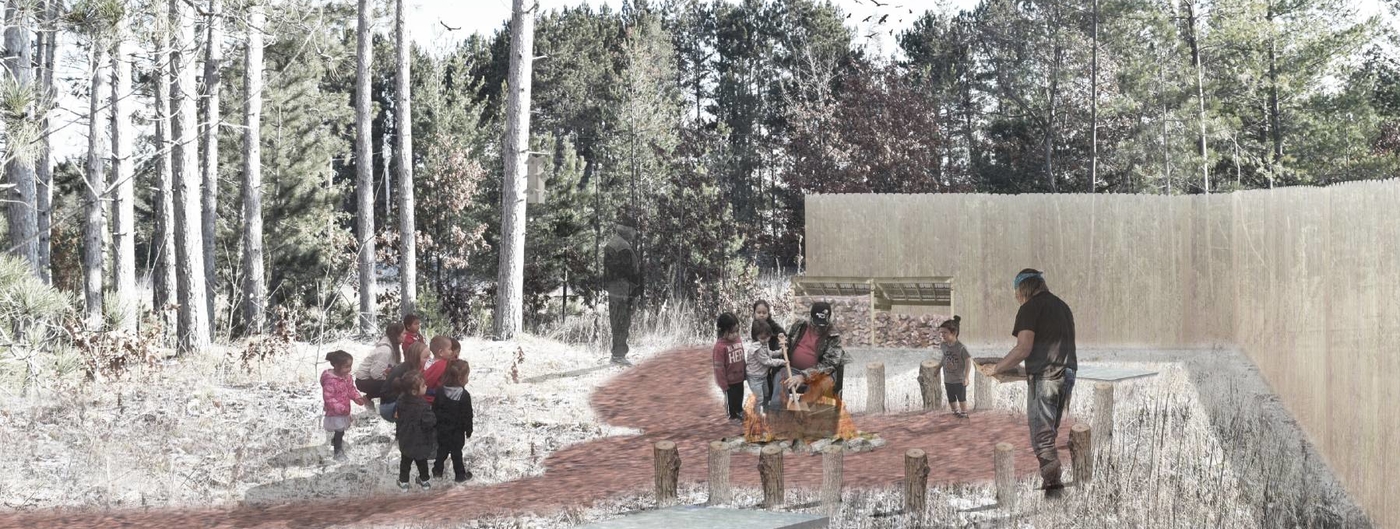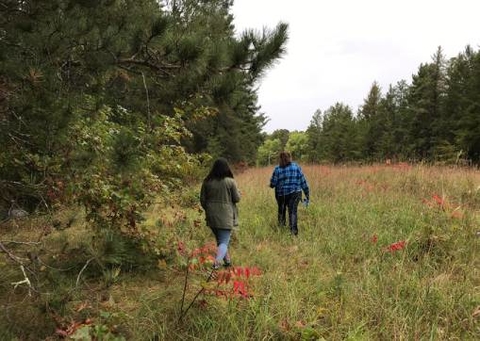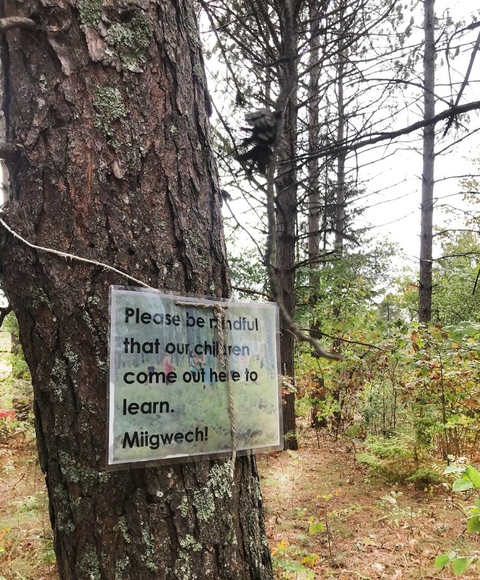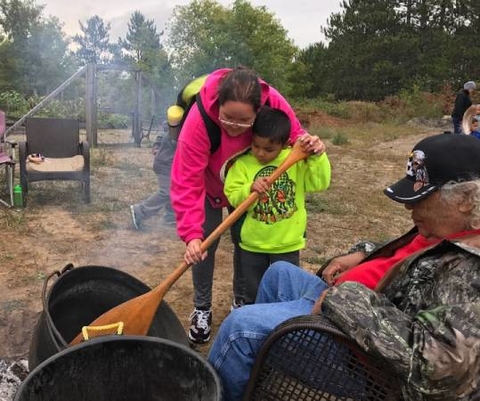Outdoor play gives children unique opportunities to explore, problem solve and engage their minds, bodies and imaginations.
A team at Leech Lake Early Childhood Development is drawing on this knowledge and exploring how to connect children in the community to nature with support from the University of Minnesota.
Waase Paulson, Leech Lake Early Childhood’s Ojibwemowin mentor, and Claire Chase, Leech Lake SNAP-ED coordinator, began envisioning how to activate the 3-acre wooded area outside of the Aabinoojii Oshkii Bimadiziiwin Center and Maajiigin building in Cass Lake several years ago. They hoped to nurture cultural traditions and connections to nature among the organization’s children and teachers.
“This was something Waase dreamt about … that we have a trail and outdoor spaces to accompany our teachings,” Chase said. “We knew we needed a space to do that and funding to do that.”
Developing and activating this space in a culturally appropriate way would support the development, health and well-being of Leech Lake’s youth and broader community.
“I started thinking about and asking, ‘What’s an Anishinaabe approach to early childhood education?’” Paulson explained. “What makes sense to me is that it would be spending time outdoors and in natural spaces in the woods.”
A community-university partnership
Drawing on connections and support from the University of Minnesota Extension Central Regional Sustainable Development Partnership (Central RSDP) and the Minnesota Indian Affairs Council, the team’s vision is now becoming a reality through the Megwayaak Project, an ongoing collaboration bringing nature play and education to the community’s children, teachers and families.
The project is working to develop a trail as well as outdoor learning and demonstration spaces in the woods located directly behind Leech Lake Early Childhood’s center. “Megwayaak” roughly translates from Ojibwe as “in the woods.”
Early in the project, Paulson and Chase connected with Shirley Nordrum, a University of Minnesota Extension educator and Central RSDP board member, who encouraged them to explore ways Central RSDP could provide additional resources and support for their efforts.
“We reached out to Shirley and told her about this idea that we had to create this space, and since then it's grown on its own. It's become its own project with its own curriculum, which is just really exciting,” Chase said.
Following Nordrum’s advice, Paulson and Chase developed and submitted an RSDP Idea Brief to Central RSDP to explore Leech Lake Early Childhood’s vision and formalize the project.
“We had a lot of different voices involved internally, and a lot of our community members were also involved throughout the process,” Paulson said. “People were really interested in this approach to early childhood. It struck a chord with them — creating these relationships for our children and natural spaces.”
The partnership helped the Leech Lake Early Childhood team hire University of Minnesota graduate students supported through the Mary Page Fund to assist with research, planning and design for the project
“We had the great benefit of working with amazing university students,” Paulson said.
Benefits of nature-based learning
Early on, the project team realized that increasing awareness about the benefits of nature play in child development would help create buy-in among the community and provide evidence to support implementation of the project.
“It was always very obvious to me that nature play would be beneficial, but having the research to back up our claims helps us build buy-in and make this relevant to our teachers’ work,” Paulson said.
The team hired graduate student Jessie Austin (University of Minnesota School of Public Health, master’s in public health, ‘19) to research the benefits of nature-based learning and play and align these findings to the objectives and domains of the Leech Lake Early Childhood curriculum.
Austin compiled this research into a report entitled “The Benefits of Nature-Based Learning and Play for Young Children's Health, Development and Well-being,” published in spring 2019. The research presents evidence that spending time outside would nurture development and promote positive health outcomes among Leech Lake youth, providing a strong foundation for subsequent phases of the project.
Austin reflected positively on the opportunity to work on this community-engaged project as a student.
“Working with Leech Lake Early Childhood Development taught me the importance of asking good questions, collaboration and how to use research to overcome challenges experienced by the community,” Austin said.
“It was one of the most meaningful experiences of my graduate program,” she added.
Bringing community-led design to life
In the next phase of the project, the Megwayaak team hired graduate student Jordan Hedlund (College of Design, master’s of landscape architecture, ‘21) to assist with site planning and design. Hedlund used an iterative approach, building on the team’s earlier research and engaging the community to complete and publish a comprehensive master plan for the space.
“In community-led design, I’ve learned how we don’t design in a vacuum, which will impact how I design as a person,” said Hedlund, reflecting on his experience during a recent statewide convening of University of Minnesota Extension RSDP staff and volunteers.
The project team praised Hedlund’s contributions in turning the project’s vision into a concrete plan for both design and programming that was grounded in the community.
“Jordan’s expertise in landscaping and environmental design were phenomenal. He was so involved. He came up several times to look at the area and talk with community members, which was really key,” Chase said, noting the importance of both trust and buy-in among community members when working with the University or other partners.
Turning a dream into reality
With the students’ contributions now complete, the Megwayaak Project is moving forward and growing its impact. The team recently secured additional funding to support implementation of the project’s site design. In addition, Paulson and Chase continue to train teachers, organize annual Nanda-gikendan events that connect indigenous food and cultural traditions to the space, and integrate Ojibwe language into the project’s learning guides.
Project partners are seeing the positive impact of this work, as Paulson and Chase’s original dream for their community becomes a reality.
“How Leech Lake Early Childhood Development leveraged their research and project work is such a great example of how our partnership model can unfold and be so successful,” said Central RSDP Executive Director Molly Zins.
“It’s a clear display of the impact these projects can have,” Hedlund said.
The Megwayaak Project team has also served as an invaluable resource to other community partners in the region and across the state on related topics, including sharing knowledge and exchanging ideas with Jean Larson, Central RSDP board member and lead of Nature-Based Therapeutic Services at the University of Minnesota Bakken Center for Spirituality & Healing.
“That kind of broader community investment in what we are doing is really helpful to carry forward in our work and to keep us going,” Paulson said.
Perhaps most importantly, children at Leech Lake Early Childhood Development will soon have access to and time in an outdoor space designed specifically to support their engagement and development with the natural world.
“I do love and support what Waase and Claire have done for the youth of Leech Lake,” Shirley Nordrum said about the project’s impact in the community.
“I love the Megwayaak Project as much as I am sure the path, the trees and the birds [are] loving the feel and the sound of the children coming back to connect with them.”
Funding for the Megwayaak Project came in part from the Minnesota Indian Affairs Council, thanks to a legislative appropriation from the arts and cultural heritage fund, with additional support from the University of Minnesota Extension Central Regional Sustainable Development Partnership.





